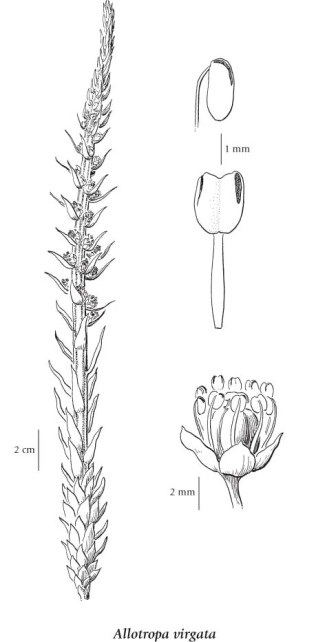candystick (sugarstick)
Ericaceae (Crowberry family)
(Previously in Monotropaceae)
Introduction to Vascular Plants
Introduction
This unusual looking species is native to the western US (CA, ID, MT, NV, OR, WA) and Canada (BC). In British Columbia, it is primarily found in the southwestern corner of the province, where it has been collected most frequently on eastern Vancouver Island. There are reports from the area north of Kamloops, and the Sicamous area. It may be overlooked in some areas.
Candystick is an erect perennial rhizomatous clonal species 10-50 cm tall with scale-like leaves and single, often multiple, unbranched stems. Stems arise from "a diffuse, deep-seated root system bearing branch roots and adventitious buds at intervals along its length" (Lichthardt and Mancuso 1991). Seeds are tiny (1 mm), with more than 100 per seed capsule, and are wind-dispersed. Plants persist after seed dispersal. Deer have been observed browsing this species, and may play a role in seed dispersal (Bureau of Land Management 2010). Candystick is a member of the Monotropoideae--the subfamily of plants within the Ericaceae that lack chlorophyll. It is mycotrophic, and obtains its food from mycorrhizal fungi that are associated with nearby coniferous trees (sometimes hardwood trees (Lichthardt and Mancuso 1991)). In BC, it has been found in mesic to dry Douglas-fir forests in the lowland and montane zones at elevations of 30 to 900 m on nutrient poor sites. In the US, it is commonly found in lodgepole pine-beargrass communities on granitic soils but has also been found under ponderosa pine, subalpine fir and western red cedar (Lichthardt and Mancuso 1991). Although not documented, it is possible that this species may exhibit dormancy and flowering stems may not appear every year--like other members of the Monotropoideae which can remain dormant for up to thirteen years (Bureau of Land Management 2010). |
Species Information
General:
Perennial herb from a rhizome; parasites on mycorrhizal fungi associated with trees; "stems" erect, simple, 10-50 cm tall, 4-10 mm thick, glabrous, white with red or maroon stripes; persistent after seed dispersal; lacking chlorophyll.
Leaves:
Linear-lanceolate, scale-like, 20-35 mm long.
Flowers:
Inflorescence a spike-like, densely-flowered, terminal raceme, 5-20 cm long (about half the length of the stem); flower stalks erect; corollas cup-shaped, the petals 5, white or pinkish to brownish, about 5 mm long; calyces generally absent, rarely 2-4 sepals; stamens 10, exserted, purplish, anthers without awns.
Fruits:
Capsules, nearly globe-shaped, up to 5 mm wide.
Notes:
Petals are often incorrectly described as sepals. Stem and leaves can be considered part of the inflorescence.
Illustration

If more than one illustration is available for a species (e.g., separate illustrations were provided for two subspecies) then links to the separate images will be provided below. Note that individual subspecies or varietal illustrations are not always available.
Illustration Source: The Illustrated Flora of British Columbia
Ecology
The table below shows the species-specific information calculated from
original data (BEC database) provided by the BC Ministry of Forests and Range.
(Updated August, 2013)
| Site Information |
Value / Class |
||
|
Avg |
Min |
Max |
|
| Elevation
(metres) |
351 | 30 | 900 |
| Slope
Gradient (%) |
31 | 2 | 70 |
|
Aspect (degrees) |
226 | 45 | 315 |
| Soil
Moisture Regime (SMR) [0 - very xeric; 4 - mesic; 8 - hydric] |
2 | 1 | 4 |
| Modal
Nutrient Regime
Class |
B | ||
| #
of field plots species was recorded in: |
21 | ||
| Modal
BEC Zone Class |
CWH | ||
|
All BEC Zones (# of stations/zone) species was recorded in |
CWH(18), ICH(2), IDF(1) | ||
|
Source:
Klinkenberg 2013
|
|||
Habitat and Range
Mesic to dry forests in the montane and lowland zones; infrequent in extreme SW BC; S to MT, ID and CA.Status Information
Similar Species
Lichthardt and Mancuso (1991) provide the following write up on similar species: "Allotropa may be confused with other non-green
members of the heath family which often share the same habitat.
Pindrops (Pterospora andromedea) has sticky, brown flowering stems that also dry and persist a long time after dying. Unlike
Allotropa, its flowers face downward, born at the ends of
delicate, reflexed pedicels. It is generally much taller than
Allotropa (3 dm to over a meter). Pinesap (Hypopitys monotropa)
is similar in height to Allotropa, but is uniformly pinkish to
straw-colored, drying to black. In flower the main stem bends
over (nods) distinctly, but straightens again as fruits develop.
Some non-green orchids, especially coralroot (Corallorhiza
spp.), are sometimes mistaken for Allotropa. Coralroot has
slender stems, rather variable in color from purplish to
reddish-brown to albino. However, stems do not bear the small,
pointed leaf blades always present on Allotropa."
|
References
Lichthardt, Juanita and Michael Mancuso. 1991. Report on the Conservation Status of Allotropa virgata (candystick) on the Nez Perce National Forest. I. Field Survey and First- and Second-year Monitoring Results. Conservation Data Center
Nongame and Endangered Wildlife Program November 1991, Idaho Department of Fish and Game.